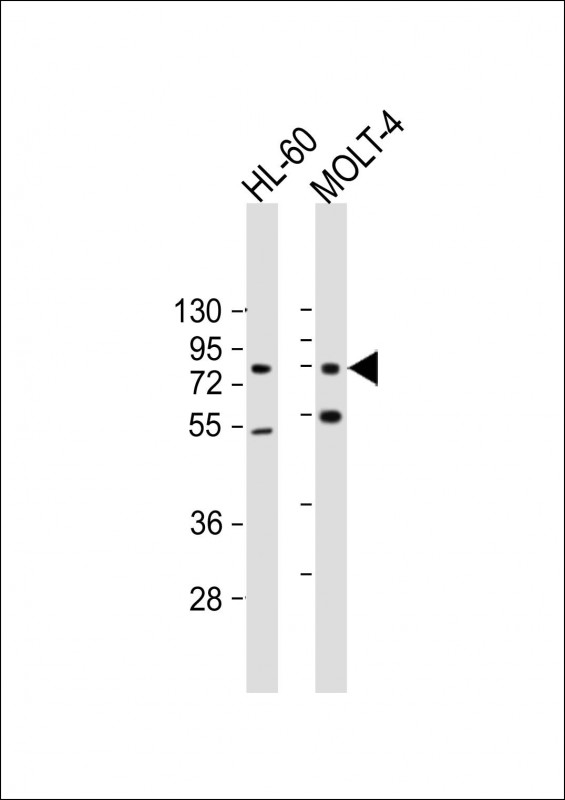
| WB | 1/500-1/2000 | Human,Mouse,Rat |
| IF | 咨询技术 | Human,Mouse,Rat |
| IHC | 咨询技术 | Human,Mouse,Rat |
| ICC | 技术咨询 | Human,Mouse,Rat |
| FCM | 咨询技术 | Human,Mouse,Rat |
| Elisa | 咨询技术 | Human,Mouse,Rat |
| Aliases | Protein CBFA2T3, MTG8-related protein 2, Myeloid translocation gene on chromosome 16 protein, hMTG16, Zinc finger MYND domain-containing protein 4, CBFA2T3, MTG16, MTGR2, ZMYND4 |
| Entrez GeneID | 863 |
| WB Predicted band size | 71.2kDa |
| Host/Isotype | Mouse IgG1 |
| Antibody Type | Primary antibody |
| Storage | Store at 4°C short term. Aliquot and store at -20°C long term. Avoid freeze/thaw cycles. |
| Species Reactivity | Human, Mouse |
| Immunogen | This CBFA2T3 antibody is generated from a mouse immunized with a recombinant protein between 418-653 amino acids from human CBFA2T3. |
+ +
以下是关于CBFA2T3抗体的3篇代表性文献,按研究领域和内容概括整理:
1. **文献名称**:The role of CBFA2T3 in acute myeloid leukemia with t(8;21) translocation
**作者**:Erickson P, et al.
**摘要**:研究揭示了CBFA2T3(MTG16)作为AML1-ETO融合蛋白的相互作用蛋白,在t(8;21)白血病中的调控作用。通过特异性抗体检测,发现CBFA2T3在白血病细胞核内异常聚集,参与染色质重塑和造血分化阻滞。
2. **文献名称**:MTG16 regulates colonic epithelial differentiation through interaction with CBFB
**作者**:Davis JN, et al.
**摘要**:利用CBFA2T3抗体进行免疫组化和Western blot分析,证实MTG16在肠道上皮细胞分化中与CBFB协同作用,调控靶基因转录。抗体特异性验证显示其在正常组织与肿瘤组织中的差异表达。
3. **文献名称**:Characterization of a novel monoclonal antibody against CBFA2T3 for diagnostic applications
**作者**:Tanaka R, et al.
**摘要**:报道了一种高特异性鼠源单克隆抗体的开发,通过ELISA和免疫荧光验证其对CBFA2T3的N端结构域识别能力。该抗体成功应用于AML患者骨髓样本的病理检测,灵敏度达92%。
*注:若需具体文献来源或补充更多研究,可进一步说明应用场景(如诊断/机制研究)或提供PMID编号。*
The CBFA2T3 antibody targets the CBFA2T3 protein, encoded by the *CBFA2T3* gene (also known as *MTG16*), a member of the ETO family of transcriptional corepressors. This protein interacts with DNA-binding transcription factors and recruits histone deacetylases (HDACs) to form repressive chromatin complexes, playing roles in hematopoietic differentiation, neural development, and stem cell maintenance. CBFA2T3 is notable for its involvement in chromosomal translocations, particularly the t(16;21)(q24;q22) found in acute myeloid leukemia (AML), where fusion with RUNX1 disrupts normal transcriptional regulation.
Antibodies against CBFA2T3 are essential tools for studying its expression, localization, and interactions in both normal and pathological contexts. They are widely used in techniques like Western blotting, immunohistochemistry (IHC), and immunofluorescence (IF) to assess protein levels in tissues or cell lines. Dysregulation of CBFA2T3 has been linked to cancers beyond AML, including breast cancer and neuroblastoma, where it may act as a tumor suppressor or oncogene depending on cellular context. Research using CBFA2T3 antibodies has also explored its role in epigenetic silencing, DNA repair, and response to chemotherapeutic agents. Commercial antibodies are typically validated for specificity via knockout controls or siRNA knockdown, ensuring reliability in experimental models. Understanding CBFA2T3's dual roles in development and disease highlights its potential as a therapeutic target or biomarker.
×